Whales are a diverse group. These creatures live in more than 70 countries and in every ocean on Earth. Today, we know more about these majestic creatures than ever before.
Whales have complex social behaviors and advanced cognitive abilities, such as self-awareness. Cetaceans are widely considered to be the second most intelligent group of mammals, after humans, based on their unusually large brains and complex social structures.
While many species of whales have been brought to the brink of extinction, there are still some amazing species we can watch in the wild today. The largest whale species in the world, based on weight & length, have been debated for decades.
There have been several estimates of the largest species, with the blue whale usually coming out on top. Scientists have identified the largest species of whales living in the world. These are the top 10 largest whale species found in oceans around the world.
-
Minke Whale
Approximate Length: 10.5 meters
Approximate Weight: 5,600 kilograms
Habitat: Northern Atlantic and Pacific Oceans
Conservation Status: Least Concern
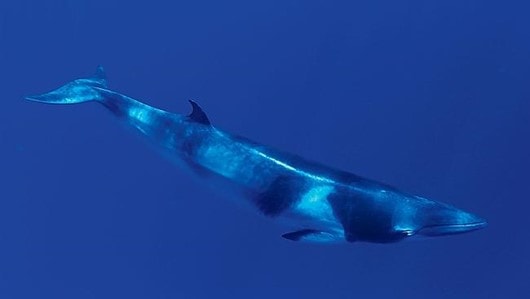 Source: Wikimedia
Source: Wikimedia
Although the Minke whale is the smallest whale on our list, it is nevertheless a large creature. These whales are typically dark in color, ranging from grey to black; some even have a violet tinge, and may reach lengths of up to 10.5 meters.
They reside in two main groups and have an average lifespan of 40 to 50 years. There are minke whales in the Northern Hemisphere and Antarctica. Although they are numerous in their many habitats, they are endangered by fishing, climate change, vessel collisions, and other factors.
Did you know?
The fact that minke whales have foul breath is one of the most well-known facts about them. Minkes are a fan favorite and can enhance the memory of a whale’s breath due to their diet.
-
Bryde’s Whale
Approximate Length: 14 meters
Approximate Weight: 13,000 kilograms
Habitat: Atlantic, Pacific and Indian Oceans
Conservation Status: Least Concern
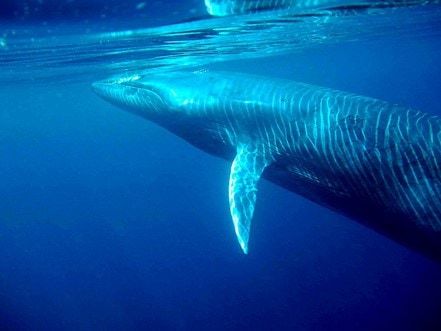 Source: Wikimedia
Source: Wikimedia
Another variety of baleen whale is the Bryde’s whale. Around the planet, warm seas are where it is frequently found. Maximum measurements for the whale’s biggest size are forty-six feet.
Two blowholes and no teeth are features of Bryde’s whales. These whales’ mouths are lined with rows of baleen plates instead.
The grey Bryde’s Whale may weigh approximately 13 tons and reach lengths of nearly that length. Although they may be spotted in bigger groups when eating, Bryde’s whales typically stay in pairs.
Did you know?
Johan Bryde, a Norwegian who assisted in establishing the first whaling station in South Africa, is honored by having his whale named after him.
-
Gray Whale
Approximate Length: 15 meters
Approximate Weight: 27,000 kilograms
Habitat: North Pacific Ocean
Conservation Status: Least Concern
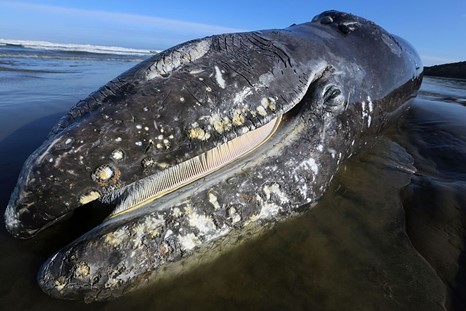 Source: Wikimedia
Source: Wikimedia
The gray whale’s combative tendencies have earned it the nickname “devil fish.” They weigh about 27 tons. They had been in the North Atlantic until being wiped off there, and they now dwell along the coast of California.
They may be identified by the typical white scars that parasites have left on their bodies. They are slate-gray in appearance elsewhere, and may be identified by their distinctive dorsal surfaces.
On the top of their heads, they have two blowholes that combine to produce a heart-shaped blow. The average lifespan of these whales is 55 to 60 years.
Did you know?
The ocean floor is where gray whales often forage because they are bottom feeders. where they spit out water and bottom-dwelling crustaceans while swallowing huge mouthfuls of silt.
-
Sei Whale
Approximate Length: 16 meters
Approximate Weight: 20,000 kilograms
Habitat: Atlantic, Pacific and Indian Oceans
Conservation Status: Endangered
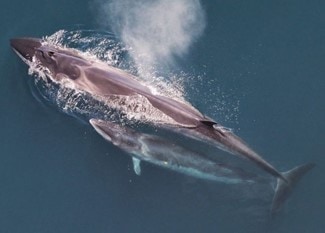 Source: Wikimedia
Source: Wikimedia
Baleen whales with subtropical, temperate, and subpolar habitats all around the world include the Sei whale. They may weigh up to 28 tons and can be distinguished from Bryde’s whales only slightly by their arched snout.
Their numbers declined during the 1900’s mostly owing to hunting. The National Oceanic and Atmospheric Administration estimates that 300,000 whales were reportedly killed during this time.
The Sei whale’s name is derived from the Norwegian word “seje,” which means “pollock.”
Did you know?
Typically, sei whales are seen on their own or in small groups of between two and five whales. They can swim at a rate of over 34 mph and are quick swimmers.
-
Humpback Whale
Approximate Length: 16 meters
Approximate Weight: 30,000 kilograms
Habitat: Worldwide Oceans
Conservation Status: Least Concern
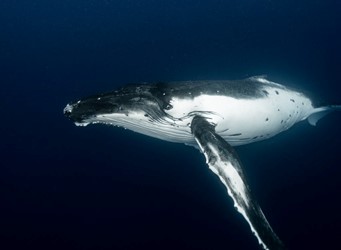 Source: Pexels
Source: Pexels
With its distinctive head shape and large pectoral fins, the humpback whale is one of the more recognizable whale species on the globe.
It is simpler to compare a humpback whale to other species of whale because of their distinct hump, from which they receive their name, and their black dorsal pigmentation. They are filter feeders, just like other whales. They consume krill and tiny fish.
Did you know?
Up to 20 kilometers distant, one may hear the melodies that male humpback whales compose and sing.
-
Bowhead Whale
Approximate Length: 18 meters
Approximate Weight: 54,500 kilograms
Habitat: Arctic and Subarctic Waters
Conservation Status: Least Concern
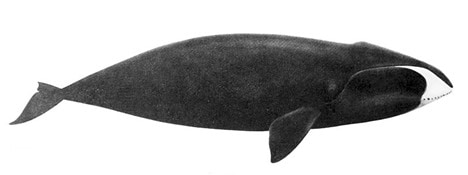 Source: Wikimedia
Source: Wikimedia
One of the largest whale species in existence is the bowhead whale. With their big, strong heads, they can break through thick ice. Apart from a white area on the lower portion of their mouth, they are fully black.
Bowhead whales may reach a massive length of 18 meters and are found in the icy seas of the Arctic and Subarctic. Though some individuals may weigh as much as 54 tons, the weight of others is much more astounding.
Did you know?
The blubber of bowhead whales is the thickest of any whale species, measuring about 50 centimeters thick.
-
Right Whale
Approximate Length: 18.3 meters
Approximate Weight: 70,000 kilograms
Habitat: Atlantic Coastal Waters
Conservation Status: Endangered
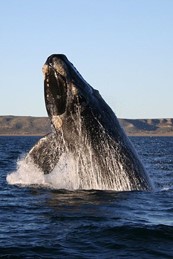 Source: Wikimedia
Source: Wikimedia
The right whale is distinguished by its spherical body, V-shaped blowholes, and very black skin. They received their moniker as a result of being singled out by whalers as the “correct” whale to harvest an abundance of flesh and blubber.
A typical right whale may reach a length of 18 meters, weigh up to 70 tons, or possibly slightly more. They may be identified by the rough skin patches on their heads that are the consequence of whale lice.
Did you know?
One of the whale species most in risk of extinction is the right whale. There will be about 350 people left in the world’s waters as of the year 2022.
-
Sperm Whale
Approximate Length: 20.5 meters
Approximate Weight: 80,000 kilograms
Habitat: Worldwide Oceans
Conservation Status: Vulnerable
 Source: Wikimedia
Source: Wikimedia
The sperm whale, the biggest of the toothed whales, is among the largest sea creatures. It is one of the few whale species that can survive in a variety of habitats and is thus present in oceans all over the world.
Male sperm whales are solitary creatures except from mating, while females move and live in groups. Sperm whales may weigh up to 56 tons and reach typical lengths of 67 feet (20.5 meters).
This species possesses the biggest brain of any animal and is the third-deepest diving mammal in the world. The oil spermaceti, which is a target of whaling, gave rise to the term.
Did you know?
In the 1800’s, sperm whaling was a significant industry that was detailed in the well-known book Moby Dick.
-
Fin Whale
Approximate Length: 27.5 meters
Approximate Weight: 72,000 kilograms
Habitat: Worldwide Oceans
Conservation Status: Vulnerable
 Source: Wikimedia
Source: Wikimedia
The second-largest species of whale in the world is the fin whale. It may dwell everywhere from the Arctic to the Pacific, but the fin whale prefers to breed in seas that are moderate.
Although these whales have a maximum weight of 72 tons and may grow to be about 27.5 meters long, they have a leaner body.
Throughout the 19th and 20th centuries, they were hunted. Approximately 725,000 fin whales were reportedly killed in the Southern Hemisphere during this time, according to NOAA estimates. Due to the cessation of commercial whaling in the 1980s, they are no longer in danger from it.
Did you know?
Fin whales have a strong respiratory system. With a single breath, fin whales may descend up to 450 meters below sea level.
-
Blue Whale
Approximate Length: 30 meters
Approximate Weight: 150,000 kilograms
Habitat: Worldwide Oceans except Arctic
Conservation Status: Endangered
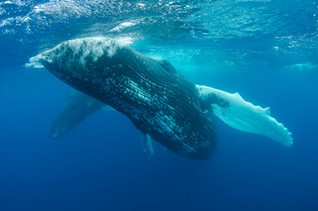 Source: Pexels
Source: Pexels
The blue whale is not only the largest whale species, but it is also the world’s largest known animal. Despite having a maximum length of 30 meters, blue whales have been reported to weigh as much as 150 tons.
Blue whales are dark blue in color, as their name would imply, with a lighter underbelly. In the course of their extensive migrations towards the Equator as winter approaches, they frequently spend the summers eating in arctic waters.
One of the species that live the longest on Earth is the blue whale. Using this technique, the oldest blue whale discovered was estimated to be roughly 110 years old. The average lifetime is thought to be between 80 and 90 years.
Did you know?
To put into perspective, a blue whale’s heart may weigh up to 600 kg. This is considered to be the size of a tiny vehicle or about 7 human beings. Their tongues can be as heavy as an elephant.
RELATED READINGS
10 Largest Sea Creatures in the World
10 Longest Animal Gestation Periods
10 Largest Oceans in the World
10 Oldest Whale Species in the World
8 Rarest Dolphins in the World
